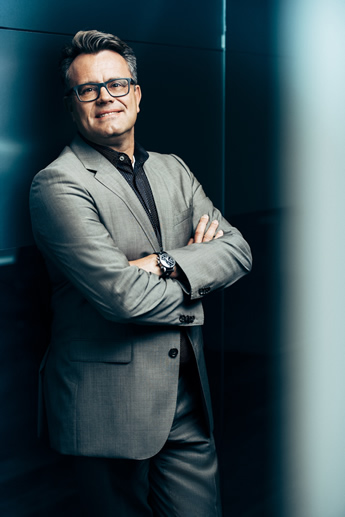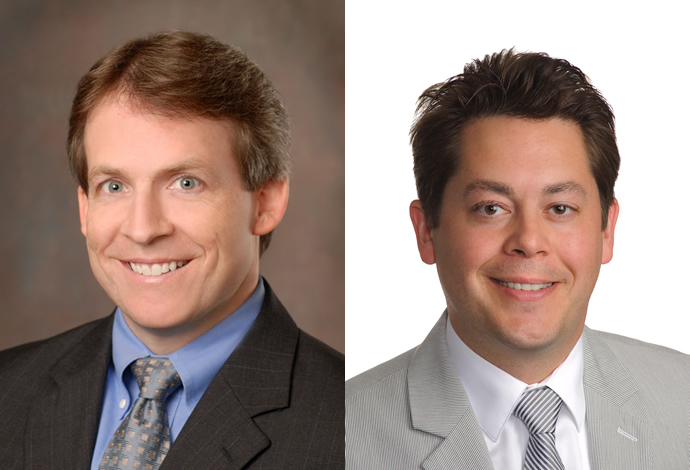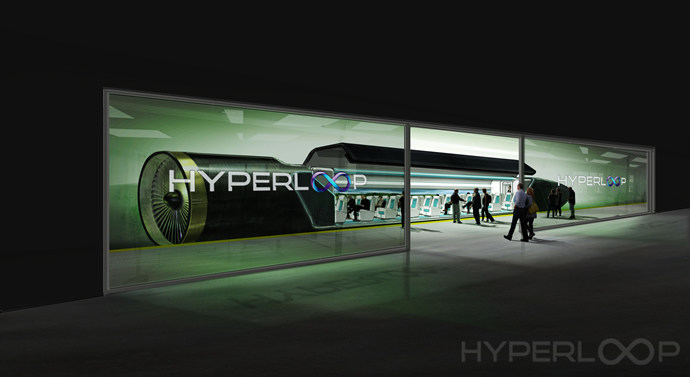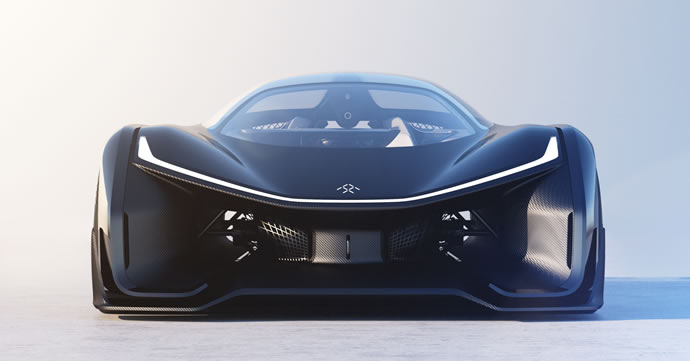If you listened to every company’s pitch at the annual Consumer Electronics Show in Las Vegas, you’d emerge thinking you’d just traveled through a time warp.
Come to think of it, Las Vegas tourists have that feeling every day.
For one of those companies, however, the time is now. The place is North Las Vegas. And the wager encompasses a whole lot more than just putting on a show.
On December 10, Faraday Future Vice President of Global Manufacturing Dag Reckhorn joined Nevada Governor Brian Sandoval and Governor’s Office of Economic Development Director Steve Hill to announce the company had selected Apex Industrial Park in North Las Vegas for a $1-billion electric vehicle production complex that could create as many as 4,500 jobs over the next seven years.
“We have completed a lengthy and thorough site selection process, and are thrilled by the opportunity to partner with Nevada to move this project forward, pending legislative approval,” said Faraday’s Reckhorn at the Dec. 10 announcement. “We are eager to begin production of our vehicle of the future — it will embrace the increasingly intrinsic relationship between technology and mobility. I would like to thank Governor Sandoval and his team as well as the local governments and the State Legislature for their tireless efforts and look forward to a continued and lasting partnership.”
“This agreement will allow southern Nevada to compete for new businesses and industries in a way that it could not before,” said Hill.

“We are entering an exciting new era of innovation, and the announcement today is further proof that Nevada is emerging as a leader in our changing global economy,” said Assembly Majority Leader Paul Anderson, as others from all sides of the aisle made similar contingent declarations. “I look forward to working with my Assembly colleagues as we review the final agreement.”
Five days later, Gov. Sandoval convened a special session to consider the deal’s incentive package, and on Dec. 21, he signed those incentives into law in the Old Assembly Chambers in Carson City.
“The passage of the legislation today signifies a new chapter for the economic opportunities of southern Nevada. I am grateful for opportunity to work with the City of North Las Vegas, Clark County and all interested parties and stakeholders to take the a large step forward in diversifying the southern Nevada economy,” said Gov. Sandoval.
Why did he specifically note “southern” Nevada twice? Because northern Nevada already has its billion-dollar baby, in the form of Tesla’s battery gigafactory. That project could involve up to $10 billion of investment by Tesla, and attracted its own $1.3-billion incentive package.
Faraday Future, with 500 employees at its base in Gardena, Calif., alone, plans to produce 100-percent-electric vehicles that offer “seamless connectivity to the outside world. In addition to producing vehicles, the company plans to explore other aspects of the automotive and technology industries, including unique ownership models, in-vehicle content and autonomous driving.”
Its primary source of cash is Chinese billionaire Jia Yueting, founder and chairman of Leshi Television. Faraday also happens to employ a number of former Tesla leaders.
By coincidence or fate, two days before the Faraday announcement, another Elon Musk dream-in-the-making — the Hyperloop Technologies high-speed transport project — had committed to a parcel in the same Apex Industrial Park. A pilot buildout of Hyperloop’s nearly frictionless pods, designed to some day travel at ultra-speed through tubes between Los Angeles and Las Vegas and up and down the California coasts, will be tested there.
Cushman & Wakefield consultants who led Faraday’s site selection process for “Project Robin” say they were completely unaware of the parallel choice of Apex by Musk’s outfit, as negotiators on the other side of the table abided by non-disclosure agreements they’d signed with prospects. Meanwhile, it’s really not that far to Tesla’s own automotive plant in Northern California, or to Proterra’s new HQ and manufacturing locations in Burlingame and City of Industry, Calif., respectively.
Ecosystem seems too mild a term. We may be witnessing the birth of a mobility solar system.
10 Months, 100 Candidates
Cushman & Wakefield Strategic Consulting led site selection and incentives negotiations for the Faraday project, completing the property search, labor market due diligence, financial evaluations and incentive negotiations over a 10-month period. The team was led by Andy Mace and Alexander Frei, heads of specialty practices within the firm’s Strategic Consulting practice, with a major assist from Keith Gendreau, project manager for the site selection.
In collaboration with Faraday Future, Cushman & Wakefield’s team evaluated over 100 properties, both brownfield and greenfield, in 10 US states and portions of Mexico, weighing expected human resources costs and labor availability, access to supplier and customer markets, real estate and infrastructure suitability and incentives.
“Few projects in the U.S. or world can match Faraday Future’s in terms of its impact not only on a specific industry but on a community as well,” said Debra Moritz, leader of Cushman & Wakefield’s Strategic Consulting practice. “This has been one of the most rewarding assignments of our team’s careers.”
In a group interview from their respective locations in York, Pa.; Minneapolis and Chicago, Mace, Gendreau and Frei say the project came their way through a series of automotive industry referrals via their Detroit office, as the deeply experienced automotive people behind the wheel at Faraday searched for that same level of expertise in property evaluation and site selection.

“The client had a very broad search area and set of possibilities” in the US and Mexico, says Mace. Three filters were used to whittle down the geography: 1) existing automotive production and supplier corridors in the two countries; 2) availability of large, existing automotive plants or buildings; and 3) leaning toward California and the western US, in order to be near the company’s targeted talent and headquarters base in Southern California.
Faraday’s team included the director of manufacturing; director of engineering; director of environment, health and safety; and leaders of the company’s supply chain, finance, PR and legal departments. “They had a very big team,” Mace says. “They put a lot of time and resources into the project, made themselves highly available and traveled extensively.”
Northern Mexico was in the mix, but Mace says consideration of Mexico did not proceed to a very advanced level. Asked if there was concern due to the number of other big automotive projects that already have landed there, he says, “At no time were we concerned about Mexico’s labor availability for this.”
A compressed time frame pushed the process through several iterations, says Gendreau, as the team performed extensive cost comparisons and studied site availability in the Western US and Mexico initially last January, then was asked by Faraday to expand the search area to include the southeastern US and other corridors.
“That process evolved into a several-month site selection effort,” says Gendreau, from March to September. The 10 states in the running: Arizona, Texas, Louisiana, Mississippi, Alabama, Tennessee, South Carolina, Georgia, California and Nevada.
“We evaluated hundreds of properties,” Gendreau says, focusing on existing large-scale, automotive-related buildings. Soon the short list was down to eight sites that were featured on a tour of Louisiana, parts of Georgia, Texas, Arizona, Nevada and California. Labor market evaluation and employer interviews followed, along with detailed cost comparisons, “and incentives were kicked into high gear at that point,” he says.
Good Size, Clear Air
Gendreau says the North Las Vegas property fared well on many site attributes, so was an early top contender, especially given Faraday’s desired proximity to the Western US. Other finalists were located in Georgia, Louisiana and California, though the consultants decline to say exactly where.
“One site had infrastructure in place already, and was very appealing to the company,” says Frei, with very low development risk. And the Louisiana site was nearly that ready to go. The Nevada site needed some work, he says, as reflected in the project’s ultimate incentive package (see below).
Soon just three finalists remained, and Frei’s United Airlines mileage account jumped accordingly, as details were clarified and meetings conducted. Mace says the front-runner kept shifting because of each site’s unique attributes, but Western proximity and outbound supply chain considerations prevailed for two of them, “because ultimately shipments out of the country could be important for the client.”

A major factor in favor of Apex turned out to be the sheer scale of the site, he says. Though Nevada’s water availability is always an issue, environmental considerations also stood in the state’s favor — because of the air. “Some of the other properties we were considering were constrained from an air emissions perspective,” says Gendreau. But though the site was looking better and better, says Frei, significant cost hurdles had to be addressed.
“It’s no surprise that some of the Southeastern locations had lower cost-of-doing-business bases, particularly on the labor side,” says Frei. “When you look at labor and other costs, adding up the cost differentials, those numbers become pretty significant.”
Especially in California.
“There seems to be incredible activity and investment in the automotive industry in California, without a doubt,” says Mace, but it isn’t necessarily manufacturing. “California can be a good place to do initial startup manufacturing, but as you grow to scale in California, the constraints on cost structure, land availability and emissions are daunting. We looked at so many sites in California, and there were so few that could even come close to being acceptable for this, especially if the client is in a hurry. It’s a great place for talent — IP, software and design — but for manufacturing, you really have to make sacrifices for California to work.”
Frei relocated three companies from California to Texas last year. They weren’t manufacturing firms, but manufacturing’s labor costs and large scale generally make the Golden State even less golden.
“That’s not to say California is a bad place,” he says, “but it’s a more expensive, more regulated state, not as quick at turning certain things around. There is a lot of talent there on the high-tech side, and it will continue to be that way. But from an emissions standpoint, in California you’re going to be restricted.”
Best If Made from Scratch
Work on solutions to narrow the cost gap in Nevada focused first on the workforce. After all, Nevada has no automotive cluster.
Gendreau says his team’s extensive employer interviews in all candidate markets included one-on-one conversations with leaders at six Las Vegas-area manufacturers, with Faraday leadership in the room, discussing applicant flow and quality, attrition and pay rates, and skill shortages, particularly in trades, welding and certificate-level programs.
“All things considered, the Las Vegas metro in general fared well, and was surprisingly good,” Gendreau says. Moreover, the trade skills alrEady evident will only be further bolstered by the workforce training aspect of the incentives package. “It was great to see that legislation pass,” he says. Among the standout aspects of the labor market: a steady influx of military retirees to refresh the applicant pool; low attrition rates (less than 10 percent); a loyal and diverse workforce; and affordable housing.

“That labor piece was obviously a huge concern and critical item for the company,” says Frei. “They’re a startup — hiring and training of employees will be something that will take up quite a bit of their resources and time. Nevada’s existing program was probably not designed for a large-scale manufacturer to come in, which was one reason why we let Nevada know that training would be a big site selection criterion.
“Nevada did what any business-friendly state would have done, and asked, ‘What are other states doing?’ ” Frei explains, studying the successes achieved by such programs as Georgia’s QuickStart, Louisiana’s FastStart (itself a QuickStart copycat) and Alabama’s AIDT. “Step two will be in the implementation,” Frei says. “It’s a new day for Nevada from a training perspective.”
Hard Assets, Hard Cash
Project negotiators also narrowed the cost gap on site infrastructure — water, rail and road, as well as low-cost financing for stormwater drainage, internal roads, sewer and other improvements.
“Other users will benefit from them in that region,” Frei says. “This project was the catalyst. Leaders saw this would be the catalyst, and were nimble and called a special session.”
Among the deal and agreement highlights:
- Approximately $85 billion in economic impact over 20 years
- 4,500 direct jobs on-site with an average wage in excess of $22 per hour and full benefits pack
- 3-million-sq.-ft. automobile manufacturing facility
- More than $1 billion of initial investment on the site within the first 10 years
- Peak construction employment of more than 3,000 construction and installation workers
- Faraday will make a direct contribution to K-12 education of $1 million per year for six years, beginning in the 2018-2019 school year.
- Faraday will prioritize the employment of Nevadans.
“The legislation requires investment thresholds to be met, quarterly reporting and annual audits to be completed, and a share in the costs of infrastructure among the property owners is required,” said Minority Leader Assemblywoman Irene Bustamante Adams on Dec. 21. “I am confident that this is a good deal for the State of Nevada and that, following approval today, the creation of high-paying jobs for Nevadans will result. I think it is important to also note the workforce training that will result from today to arm our citizens with the skills they need to succeed in the jobs of our state’s future.”
“These sweeping measures signed into law today will be transformative for the southern Nevada economy and will resonate for generations.” — Nevada Governor Brian Sandoval, Dec. 21, 2015, on signing four measures into law that make the $1-billion Faraday Future investment viableThe estimated value of state incentives is approximately $217 million over 15 years, depending upon the ultimate scale of the investment. Frei says the comprehensive total of incentives comes to roughly $335 million. The state package includes:
- 100-percent abatement of Sales & Use Tax (15 years)
- 75-percent abatement of Real Property Tax (10 years)
- 75-percent abatement of Personal Property Tax (10 years)
- 75-percent abatement of Modified Business Tax (10 years; company will receive standard abatements upon approval. Company will pay enhanced abatements and will receive rebate once $1 billion investment has been made.)
- Transferable Tax Credit of $9,500 per permanent, full-time job, up to 4,000 jobs — average wage of jobs must be $22 per hour to qualify
- Economic Development Rate Rider: Remaining 25 MW of electricity will be made available through the Economic Development Rate Rider program (10 years)
- NDOT will advance a previously planned project to construct and install an enhanced interchange at the intersection of I-15 and U.S. 93, widen U.S. 93 to four lanes to Apex Power Parkway, and add an elevated left turn lane at Grand Valley Parkway ($50 million)
- Ensure a municipal water infrastructure system is available at the project site ($35 million)
- Construction of a rail port and associated rail infrastructure ($35 million)
- Using the $3-million Workforce Innovations for the New Nevada (WINN) Fund, the state will construct a training program sufficient to provide training for up to 4,000 automobile assembly workers at the facility. The program will train up to 800 workers in any given 12-month period.
According to analysis by Applied Economics at the behest of the Governor’s Office of Economic Development, the company would open with about 50 jobs and $2.4 million in payroll. By 2023, Faraday would expand to 4,500 jobs and $206.1 million in payroll. “Through their local supplier purchases, as well as employee spending, they could create an annual economic impact of $5.6 billion at full operational/stabilized levels,” read the analysis.
- Project will generate approximately 9,000 indirect jobs in the community, for a grant total of 13,500 jobs
- Faraday will increase manufacturing employment in Clark County by more than 20 percent.
- Direct economic impact generated by the project will be $55 billion over 20 years; indirect economic impact will be approximately $30 billion over 20 years
- Gross Regional Product in Clark County would increase by up to 4 percent
- Tax revenues would include $230 million in state General Fund revenue, $270 million in local government revenue and $260 million in K-12 education revenue over 20 years.
“Economic diversity doesn’t just happen; it requires goals, strategy, and action,” said Nevada Assembly Majority Leader Paul Anderson on the day the four new laws were signed by the governor. “Today we took an important step in continuing Nevada’s momentum to further solidify our state’s role in the future of the advanced manufacturing and innovative transportation industries.”
Frei says the parties are finalizing details of the real estate transaction now. Meanwhile, the language of the incentives legislation, like that of the special legislation for Tesla’s Gigafactory, is written so that “any supplier that locates within the site will be awarded the same benefits. They just need to be added to the list of participating firms, and that’s it. That was part of the discussion from day one, and we find that to be an important consideration for an automotive company that relies on a large number of suppliers. If the suppliers are able to get benefits, they can be more competitive with pricing to Faraday. They might be separate companies, but it’s all one project.”
One project, sure. But one of several separate projects forming a hyperloop of mobility innovation out West. They are the moving parts in a bigger, regional supermegaproject that just might change the face of transport as we know it.


